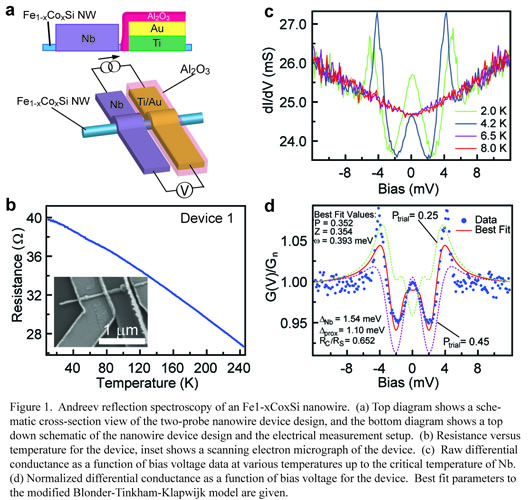John (Jack) DeGrave

Graduate Student, Physical Chemistry
Department of Chemistry
University of Wisconsin-Madison
Biographical Sketch
B.S. Hillsdale College, Chemistry and Mathematics, 2008
PhD University of Wisconsin-Madison, 2008-Present
Research
My thesis work is focused on the synthesis and characterization of silicide and germanide nanowire materials that will be relevant to spintronics technology. Conventional electronics are quickly approaching the minimum size limit for basic circuit elements that function above the relevant length scales for quantum effects. Spin-based electronics or “spintronics” attempts to further increase the functionality of devices by manipulating the spin of the electron in lieu of or in addition to the charge.
The efficiency of certain spintronics phenomena are directly related to the spin polarization of the material in question. For this reason, I have developed an all electrical method to measure the spin polarization of nanowire materials, namely Andreev reflection spectroscopy (Figure 1). This technique takes advantage of superconducting heterojunctions where the probability of an Andreev type process can be used to determine the spin imbalance in the material of interest. It has been theoretically proposed that Fe1-xCoxSi is a half-metal (100% spin polarized at the Fermi level) for x ~ 0.2. The Andreev reflection measurements indicate that the actual spin polarization is likely no greater than 35% for Fe1-xCoxSi nanowires.

More recently, the B20 silicides and germanides (examples: MnSi, Fe1-xCoxSi, and FeGe) have garnered a great deal of interest due to their exotic magnetic textures, namely the helimagnetic and Skyrmion phases (Figure 2). We have identified the electrical signal of the helimagnetic phase in MnSi nanowires, and we are currently developing techniques to measure the electrical and magnetic signals of the Skyrmion phase in nanowires. This on-going work will further the understanding of Skyrmion phase formation, manipulation and control for device functionality.

Publications
1. DeGrave, J. P.; Liang, D.; Jin, S.: A General Method to Measure Hall Effect in Nanowires: Examples of FeS2 and MnSi. Nano Lett. 2013 (submitted).
2. Caban-Acevedo, M.; Liang, D.; Chew, K. S.; DeGrave, J. P.; Kaiser, N. S.; Jin, S., Synthesis, Characterization, and Variable Range Hopping Transport of Pyrite (FeS2) Nanorods, Nanobelts, and Nanoplates. ACS Nano 2013, 1731-1739. (link)
3. DeGrave, J. P.; Schmitt, A. L.; Selinsky, R. S.; Higgins, J. M.; Keavney, D. J.; Jin, S.: Spin Polarization Measurement of Homogeneously Doped Fe1–xCoxSi Nanowires by Andreev Reflection Spectroscopy. Nano Lett. 2011, 11, 4431-4437. (link)
4. Higgins, J. M.; Carmichael, P.; Schmitt, A. L.; Lee, S.; DeGrave, J. P.; Jin, S.: Mechanistic Investigation of the Growth of Fe1−xCoxSi (0 ≤ x ≤ 1) and Fe5(Si1−yGey)3 (0 ≤ y ≤ 0.33) Ternary Alloy Nanowires. ACS Nano 2011, 5, 3268-3277. (link)
5. Higgins, J. M.; Ding, R.; DeGrave, J. P.; Jin, S.: Signature of Helimagnetic Ordering in Single-Crystal MnSi Nanowires. Nano Lett. 2010, 10, 1605-1610. (link)
